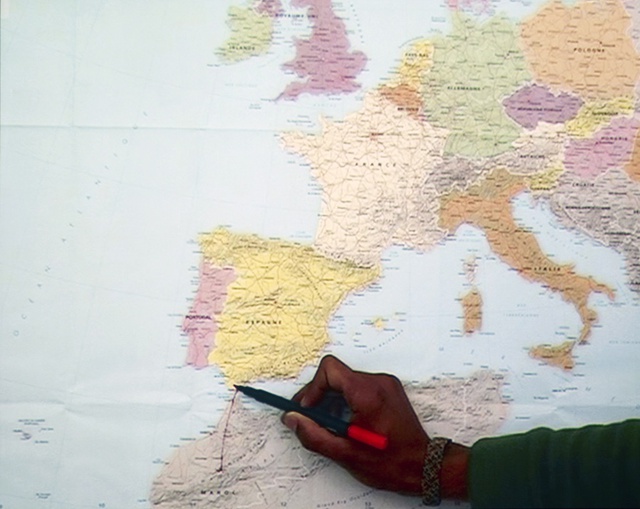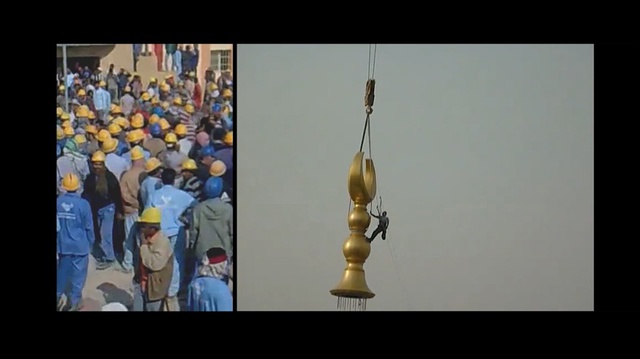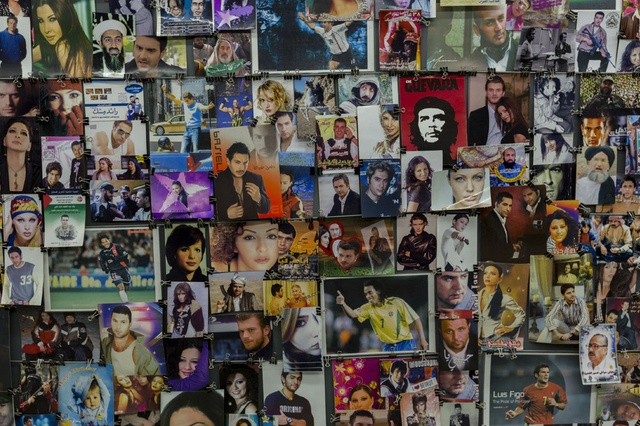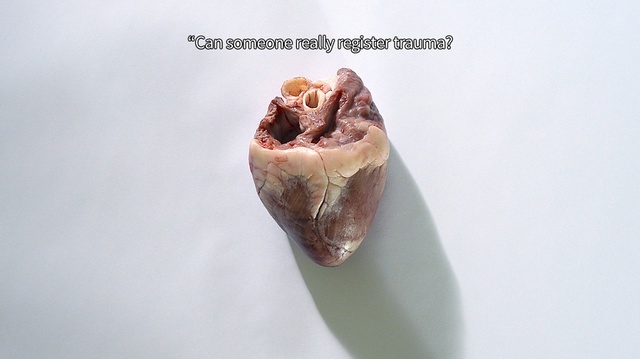Reviews
Mirror Worlds
Here and Elsewhere at the New Museum
For all our reliance on images, we never quite believe in their revelations.
– Frances Guerin and Roger Hallas, The Image as Witness
There could not have been a better title for an exhibition of contemporary art from the Arab world staged in 2014 by a western institution (the New Museum) than Here and Elsewhere. Named after Ici et Ailleurs, the 1976 film-essay by Jean-Luc Godard, Jean-Pierre Gorin and Anne-Marie Miéville, the reference was the perfect frame to the frame: fluid enough to get away with a presentation of 45 artists from 15 countries that the New Yorker’s Andrea K. Scott supposed would have sounded like Edward Said’s nightmare’ – ‘an invitation to reduce a nuanced and inevitably provocative subject to a cliché.’[1] After all, one of the issues Ici et Ailleurs considered – aside from the un/reliability of images – was how to view and experience a revolution elsewhere (in the film's case, the Palestinian liberation movement), here (or in more specific terms, the western world), and vice versa.
This double-sided investigation was established not only in the film’s title (not Here or Elsewhere, but Here and Elsewhere) but also in its final edit, in which footage from two worlds collided: the militant struggle in the Palestinian camps of Jordan, Lebanon and Syria, and a family sitting in their living room, watching TV in Europe. At one key point, Godard ruminates on the difference between the words ‘and’ and ‘or’. The former is posited as an antidote to the all-too-easy tendency to divide the world in a binary two: both an addition and a subtraction; positive and negative – a window ‘experienced as simultaneously transparent and opaque’ between one world and another.[2]
It was this (convenient) window that the New Museum curators used to produce an exhibition that evaded the kind of critique one might level at a regionally framed show like this – especially one that began with the working title, ‘Yalla!’ (an exclamation commonly meaning 'come on!' or 'let's go!' – akin to naming a show on French art, Salut! or on Greek art, Ela!). The evasion was most evident in the curatorial essay, meticulously written by artistic director and curator Massimiliano Gioni and curatorial associate Natalie Bell, to bypass any accusations of cultural reductionism by pre-emptively acknowledging every possible criticism such a curatorial might invite. Yet, regardless of the self-conscious effort, it is true what Hyperallergic’s Hrag Vartanian noted of the curatorial essay: it felt like an apology of sorts, as much as the exhibition title felt like ‘a tactic to move some responsibility from the curator onto an artwork that we’re lead to believe encapsulates the issues at hand.’[3]
But that is not to say that the show didn’t work. As one artist who declined to take part in the exhibition observed, this could have succeeded as an exhibition completely unassociated with the region itself. And context here is key: this is one of the few attempts at presenting art from the Arab world in New York, let alone the United States, which may explain why the original title implied an invitation to a journey of sorts – and thus an introduction – from one place to another.
Indeed, where Here and Elsewhere succeeded was that it faced the problem of curating a region by turning the question of how the ‘Arab world’ is viewed into a curatorial concept. This started with the exhibition’s main intent: to present artists who ‘share roots in the Arab world and a critical sensibility with regard to images and image-making.’ Note the wording: many of the artists showing are in fact based outside of the Arab world, while some were not born there altogether – another reality for a geography that has been at once subject to definition and a victim to it, historically speaking. Thus, the boundaries of the region in question remained expansive, elastic, and undefined. This was articulated in the choice of works on show, carefully selected to underscore the porosity of borders through an emphasis on photography, documentary and archival practices. In Ahmed Mater’s Leaves Fall in All Seasons (2008–2013), a series of collected videos taken by Mater himself or collected from YouTube, explore the development around Mecca, including the lives of labourers from Palestine, Egypt, Tunisia, Lebanon, India, Bangladesh, Turkey, Algeria, Morocco, Syria, Philippines, Nepal, Yemen and China. In Bouchra Khalili’s Mapping Journey Project (2008–2011), migrants trace their journeys from their home countries to their final destinations on a map; a break down of borders through the individuals that cross them.
In this, Here and Elsewhere dealt with the problem of how one might curate, let alone define, a region by turning everyone – both artists and spectators – into its witnesses, from near and afar. Thinking back to Khalili’s mapping projects, the result was thus not only a stretching of space, but also of time – both of which lay at the core of Basma Alsharif’s film, We Began by Measuring Distance (2009), which tells the story of Palestine through a group of people who devised a game of measuring, amongst other distances, the length between Gaza and Jerusalem showing how these distances changed according to the year in which they were measured.
Further destabilizing borders, maps, distances and histories was Rana Hamadeh’s The Big Board – a war room map in which people, places and histories are connected, from a piece of the Berlin Wall to a plague doctor in ancient Athens, to a boat just off the coast of Marseille, close to a refugee compound. In one part of the map, the words: ‘WHO ARE YOU?’ – a question that essentially reveals what these acts of mapping reflect: the position of the individual and the varying degrees to which experience and impression are inscribed into singular perspectives when it comes to the events that serve to define collective identities and historical narratives. This kind of granular relativity – between an event and its subjects and objects – is what runs through Lamia Joreige’s ongoing project, Objects of War (1999–), in which Joreige invited people to presents objects that reminded them of wars in Lebanon, presented alongside various video interviews in which these subjects discuss their selection.
Indeed, in thinking about the region as a distinct geography and as a point where histories converge, the issues are in fact both regional and global, which is precisely what Ici et Ailleurs was getting at when Godard narrated how ‘any daily image will also be part of a vague and complicated system where the whole world enters and leaves at each moment.’ This point was underscored with Here and Elsewhere in an unfortunate coincidence: the show opened just after Israel commenced Operation Protective Edge over Gaza, which only served to highlight the strong Palestinian representation in the exhibition.[4] The reason for such an approach was clearly articulated by Ala Younis’s curated section of the show – An Index of Tensional and Unintentional Love of Land, which brought together ‘images, artworks, photographs and documents of visual culture that undermine stereotypical representations of conflict.’[5] What Younis proposed was an attempt at narrating a recent history of the Arab world by tracing ‘the impact of the Palestinian struggle on the ideals, efforts, and discourses that reverberated across different times and geographies.’[6] And yet, that history is not geographically confined to the Arab world: the Palestinian situation is, after all, a global issue.
Thus, the Palestinian narrative continued throughout the show, most notably in one room, where Wafa Hourani’s visions of possible future Qalandiyas in the Future Cities series (2009) – dioramas made from glitter, card and other modeling materials – was presented alongside Alsharif’s We Began by Measuring Distance, Khaled Jarrar’s documentary following attempts to climb over the separation barrier between Israel and the occupied Palestinian territories, Infiltrators (2012), and Shuruq Harb’s project, The Keeper (2011–2013). This latter archive was born out of a series of encounters between Harb and a young Ramallah-based image vendor, Mustafa, who has been carrying on a family business in which photographs of politicians, celebrities and television stars, mostly collected online, are printed and sold. In a video accompanying a wall of images presented as part of the show, including an image of Leo DiCaprio and a number of Turkish soap opera stars and Che Guevara, Mustafa explains how the popularity of certain images waxed and waned in accordance to the times (demand for Saddam Hussein’s portrait peaked after his execution, for example).
Then there were the collection of portraits by Hashem El Madani, including students of the UNRWA school in South Lebanon taken in 1971, and portraits of Palestinian and pro-Palestinian resistants taken between 1970 and 1972 in Saida. As is well documented, the Arab Image Foundation – itself a repository of photographic documents in which history is being reconstructed and reassembled – resurrected El Madani’s extensive archive after discovering it: a project of AIF co-founder Akram Zaatari that reveals the impetus behind the archival impulse that has become one of the characteristic approaches for many art practices dealing with the region as its subject matter.
As Antonia Carver explained during ‘Curating the Region,’ an ArteEast conference held at the New Museum one day before the exhibition closed, there is a real and urgent need to explore the vast wealth of histories that have yet to be uncovered. Reflecting on Art Dubai’s newly launched Modern section, Carver observed that when it comes to art in the region it can often be a case of working backwards, rather than forwards. In Here and Elsewhere, the past was represented through Etel Adnan’s paintings, a number of extraordinary ceramics by Simone Fattal, a haunting collection of canvases depicting distorted figures by Marwan (a nod to his training as a painter in West Berlin), visceral and masterfully composed collages by Ali Jabri, and a remarkable group of self-portraits by Armenian-Egyptian photographer Van Leo from the 1940s (the decade Leo established a successful photography studio). In the latter, Van Leo – also an AIF discovery – presents himself as a number of flamboyant characters, from a ship captain to a young woman with a nipple exposed (an homage to the aesthetic conventions of the theatrical headshot).
Yet, this need to delineate a culturally located sense of art history – and the desire to write or rewrite it – can be as unsettling as it is necessary, depending on who is doing the writing, and for what purposes. The inclusion of works by one Suha Traboulsi, apparently a fictive Palestinian concocted by Walid Raad, destabilizes the very certainty with which survey exhibitions – which the New Museum emphatically emphasizes that Here and Elsewhere is not – are able to present any kind of historical, or indeed cultural, lineage. But the curators of Here and Elsewhere anticipated such an argument, too. So they approached this exhibition as a plateau within which dissonance thrives and time is meta: the catalogue includes three Bidoun-facilitated round tables themed around Past, Present, and Future. At one point, when discussing how walking is very much part of Anna Boghiguian’s practice, Bidoun (interviewing under the magazine title) note: ‘that’s the wisdom of street-people knowing that official narratives can be nothing more than semantic games or lies.’ In this, quoting Barry Schwabsky for The Nation, ‘Fact and fiction are equally aspects of whatever truth can be gleaned from the disorder that is life itself.’ As such, quoting Schwabsky again: ‘All the problems of art … stem from the fact that it is created partly from what is given, partly from what we can invent. It involves both external and internal necessities whose relation can never be fully resolved.'[7]
This brings us back to the show’s curatorial approach and the problems that lie therein. During the exhibition’s conference, Natalie Bell explained how the intent was to explore the role of artists in the face of historical events, and how artists today interrogate their own histories (and within this, their art histories) through the unpacking, unearthing and at times re-assessment of history’s documents. This oft-obsessive, oft-irresolvable recuperation recalls an observation Merleau-Ponty once made in The War Has Already Taken Place: that though an ‘obsession may indeed be motivated by an individual’s past … it yields more than it promises: it has, when actualized, its own weight’ – ‘the brute force of the present and of what exists.[8]’ But by attempting to define the present condition of a geographical or cultural region curatorially – an unresolvable amalgamation of time, space and narrative – the same problem Godard observed back in the 1970s emerges. The world is too much for one image, but international capitalism will always deny such a claim, given it builds its wealth on this homogenizing truth of a supposed plurality contained within a frame, which brings us back to the exhibition under discussion.
Where Here and Elsewhere’s curatorial really succeeded was in its inherent contradictions. Taking great pains to defend the cultural specificity of the exhibition not so much as an ‘essentialist framing of the work of artists who, to varying degrees, are connected to the Arab world, but rather as a refusal of a pluralist, neoliberal paradigm that reduces difference in the name of a universality that only recapitulates the homogenizing forces of the global economy,’[9] the show succumbed to its own refutations. In fact, to present any region within a singular ‘regional’ or ‘cultural’ frame is as much a neoliberal move as any other. But rather than masking these contradictions, the curators allowed them to run rampant within the New Museum’s galleries.
Indeed, this was a hefty and chaotic show – loud, uncompromising; best articulated in how sound bled from one work to another, from the clashing musical score in a video depicting Akram Zaatari watching unidentified images on a computer screen with Hashem el Madani in one room impinging on the sound emanating from Mounira Al Solh’s Now Eat My Script (2014) in another, to Amal Kenawy’s melancholy, grunge soundtrack in The Purple Artificial Forest (2005) competing with the voice of Wael Shawky reciting the Surah al-Khaf as he walks through a supermarket in The Cave. At the same time, the show had its moments of saturated silences, too: from Hrair Sarkissian's haunting images of execution squares in Aleppo, Lattakia and Damascus, and Rokni Haerizadeh's melancholy hand-painted interventions on photographs taken from Femen protests in Subversive Salami in a Ragged Briefcase, presented along silent animation, Just What Is It That Makes Today's Homes So Different, So Appealing?
As an exhibition that relied on testimony and documentation – what Ranciére would call processes seeking new perceptions of history and signs of community, and what Frances Guerin and Roger Hallas would call images that not only depict the historical but participate in its transformation – Here and Elsewhere felt like an articulation of (and reaction to) Godard’s observation that, ‘little by little, we’re being replaced by chains of uninterrupted images … Each image in its place, as we are each in his place, in the chain of events over which we have lost all control.’ Yet as effectively as this was expressed, the question remained: in side stepping clichés, did this exhibition inadvertently produce new ones?
[1] Andrea K. Scott, 'Out of Place,' The New Yorker, 25 August 2014, http://www.newyorker.com/magazine/2014/08/25/place.
[2] I am borrowing here from Rosalind Kraus, who discussed the symbolist window as a manifestation of the abstract grid in her essay 'Grids'.
[3] Hrag Vartanian, 'Four Questions for Contemporary Arab Art,' Hyperallergic, 28 September 2014, http://hyperallergic.com/151742/four-questions-about-contemporary-arab-art.
[4] (It was well-publicized that Khaled Jarrar was barred from leaving Palestine and thus unable to attend the opening of the show and his own artist’s talk at the museum.)
[5] Ala Younis, 'An Index of Tensional and Unintentional Love of Land,' Universes in Universes, September 2014, http://universes-in-universe.org/eng/nafas/articles/2014/love_of_land.
[6] Ibid.
[7] Barry Schwabsky, 'Under Pressure', The Nation, 23 September 2014, http://www.thenation.com/article/181725/under-pressure
[8] Maurice Merleau-Ponty, 'The War Has Already Taken Place', in The Merleau-Ponty Reader, edited by Leonard Lawlor and Ted Toadvine (Northwestern University Press, 2007), p.42.
[9] Also quoted by Hrag Vartanian in 'Four Questions for Contemporary Arab Art,' Hyperallergic, 28 September 2014, http://hyperallergic.com/151742/four-questions-about-contemporary-arab-art.



















